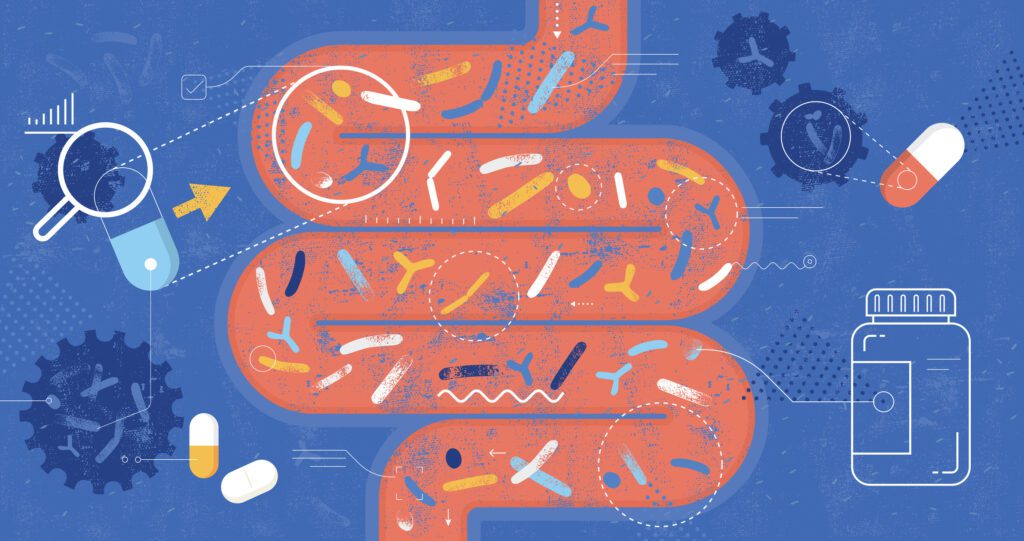Should You Incorporate Them into Your Daily Diet?
Probiotics have long been known to soothe digestive disorders like acid reflux, diarrhea, and constipation. Lately though, these “good bacteria” are cropping up in all sorts of products, from toothpaste to cereal. We share what’s hype and what’s fact before you incorporate them into your daily diet.

According to the International Scientific Association of Probiotics and Prebiotics, probiotics are live microorganisms that, when consumed in suitable amounts, provide a positive health benefit to the receiver. Essentially, probiotics are “good” bacteria that contribute to your overall health. Dr. Sarah Worley, an internal medicine physician with UT Erlanger Health and Wellness of Signal Mountain, explains, “Often, probiotics help defend the body from infections caused by unfriendly bacteria or other germs.”
They’re part of something called “gut flora.” Gut flora, also referred to as gut microbiota, is the overall microbe population living in our intestines. Comprised of tens of trillions of microorganisms and more than 1,000 species of known bacteria, some experts consider the microbiota to be a virtual endocrine organ on its own, due to the sheer number of functions it can accomplish. These include producing vitamins B and K, acting as a barrier in the immune system, and aiding in digestion, among many others.
Not only are probiotics found naturally in our bodies, but you can also get them from foods like yogurt, kefir, sauerkraut, kombucha, and kimchi, or you can purchase them in supplement form. Amanda Blevins, a nurse practitioner with Parkridge Medical Group – East Ridge, shares, “Probiotics found in food are not at a level to provide benefits by themselves. An added oral probiotic supplement contains more helpful microorganisms.”
So, should you be upping your intake of these probiotic-rich foods and supplements to stay healthy? With increasing popularity and awareness of probiotics and their benefits, it is important to know all the facts concerning the sought-after bacteria before diving in head first.
They Need Prebiotics
Prebiotics are dietary fibers that feed or “fertilize” the probiotics in your gut. They do this by resisting digestion and absorption in the GI tract and selectively stimulating the growth of “good” bacteria. Essentially, prebiotics help probiotics multiply. “Prebiotics can be naturally occurring in certain foods or can be found in pill form,” says Dr. Shannon McCallie, an internal medicine specialist with Galen Mountain View Medicine.
To increase the number of desirable bacteria in your digestive system, which are associated with better health and reduced disease risk, try foods rich in prebiotics like onions, garlic, asparagus, bananas, apples, barley, and many others. For some prebiotic-rich foods, it is best to eat them raw, since cooking them could alter the fiber content.
Most Come in Two Groups
The two main groups of probiotics are Bifidobacterium and Lactobacillus.
Bifidobacterium is a part of the lactic acid group of gut bacteria and is known to calm intestinal issues such as diarrhea, irritable bowel syndrome, and constipation. “Probiotics that fall under the bifidobacterium umbrella are considered useful in cases where disease might kill off normal bacteria. For instance, when an antibiotic is used to destroy disease-causing bacteria, it will also kill good bacteria. So taking probiotics during antibiotic treatment can restore balance,” explains Dr. McCallie.
Lactobacillus is also a “good” bacteria that can be found in our urinary, genital, and digestive systems. Like the Bifidobacterium group, Lactobacillus aids in preventing digestive issues like diarrhea, constipation, and irritable bowel syndrome. Its effectiveness is also being tested for other issues like urinary tract infections, ear infections, dental cavities, fever blisters, and acne, though more research is required to draw measurable conclusions. “Lactobacillus is the most common strain found in many probiotics and is involved in many ongoing studies,” says Dr. Worley.
The FDA Doesn't Regulate Them Like Drugs
The U.S. Food and Drug Administration (FDA) is the federal agency tasked with reviewing the safety of food, medical devices, cosmetics, drugs, and more. With drugs especially, the FDA requires that manufacturers prove the prescription is safe and effective. Most probiotics fall under the food or dietary supplement categories, which means they don’t need approval from the FDA before they are marketed. Dr. Worley explains, “The companies that package probiotics products don’t have to prove that the ingredients listed on the label are actually in the product.” So, while these companies can’t make health claims about specific diseases, they can make vague claims like “improves digestive health” even though there are no standardized amounts or minimum levels of microbes required.


People with Immune System Issues Should Avoid Them
Since those with weak immune systems can be affected negatively by probiotic consumption, it is important to talk to your doctor before taking probiotic supplements or eating probiotic-rich foods.
“For people in good health, I usually recommend a daily probiotic supplement containing at least 10 billion CFUs (colony forming units),” says Blevins. “But populations that are immunocompromised or patients who are critically ill should avoid probiotics altogether.”
That’s because probiotic consumption in individuals with weakened immune systems can lead to infection or other serious complications. It can also lead to more minor side effects like upset stomach, diarrhea, gas, and bloating.
They Can Take a While to Work
Once you begin including probiotics – whether through foods or supplements – into your daily routine, don’t necessarily expect to see results overnight. Depending on the person, the symptoms, and the specific probiotic ingested, results can take anywhere from a few hours to a few weeks to kick in.
How quickly a probiotic works depends on the generation time of the bacteria. “The generation time is the amount of time it takes for bacteria to double,” says Dr. McCallie. Lactobacillus and Bifidobacterium have short generation times, so they can start working within a few hours of consumption. Conversely, other strains may take several days to reach their full therapeutic ability.
Pay attention to the label as well as your body’s reaction to the probiotic. Don’t be discouraged if you’re not seeing an immediate impact.
They Have a Shelf Life
Just like other living things, probiotics have expiration dates. One of the major risks to live bacteria is oxygen toxicity, or an overabundance of oxygen. This can slow the activity and kill off bacteria. Probiotics need very little oxygen to grow (some even grow in the absence of oxygen), so too much can be a serious hinderance to their survival.
To prevent probiotics from expiring early, you may have to consider where you store them so that the bacteria remains active. Some require a cool, dark environment, while others may need to stay at room temperature. “The refrigerated probiotic supplements contain the most live microorganisms and seem to have better results,” says Blevins. Be sure to check labels for expiration dates, proper storage, and usage.
While it’s important to remember that there is still more research to be done in the field of probiotics, early studies look promising. The hope is that these “good” bacteria will one day be used to treat or prevent a number of disorders. By staying updated and informed, your health remains a priority, and there’s nothing “bad” about that!


Dr. Sarah Worley
Internal Medicine Physician, UT Erlanger Health and Wellness of Signal Mountain


Amanda Blevins
Nurse Practitioner, Parkridge Medical Group – East Ridge


Dr. Shannon McCallie
Internal Medicine Specialist, Galen Mountain View Medicine

